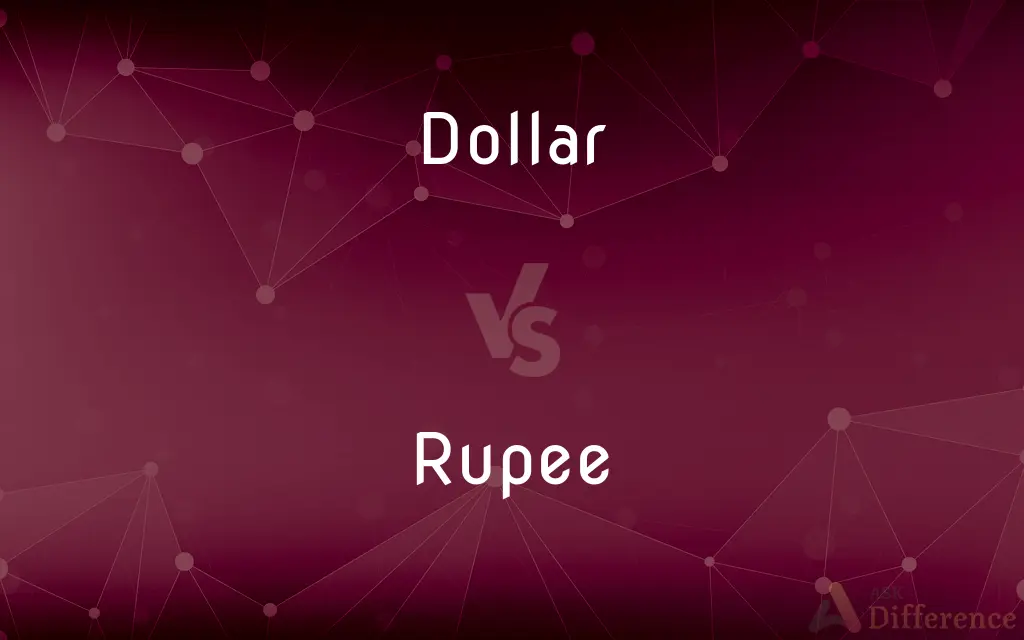Dollar vs. Rupee — What's the Difference?
By Fiza Rafique & Maham Liaqat — Updated on March 29, 2024
Dollar is major global currency used in United States and other countries, symbolizing economic strength, while rupee, used in India and several other countries, reflects regional economic status, showcasing differences in value, influence, and usage.

Difference Between Dollar and Rupee
Table of Contents
ADVERTISEMENT
Key Differences
The dollar, particularly the United States Dollar (USD), is one of the world's primary reserve currencies, widely used in international trade and investment. Its strength and stability are backed by the U.S. economy, the largest globally. In contrast, the rupee, with the Indian Rupee (INR) as a prominent example, is the official currency of India, and also used in Pakistan, Sri Lanka, Nepal, and Indonesia under different forms and names, reflecting the economic practices of these regions.
The value of the dollar against the rupee can fluctuate due to various factors, including economic policies, inflation rates, and political stability. These fluctuations impact international trade, investment, and the purchasing power of individuals in countries using these currencies. For example, a strong dollar can make imports cheaper in the U.S. but can adversely affect the economic balance in countries like India, where the rupee might depreciate in value against the dollar, making imports more expensive.
In terms of issuance and regulation, the dollar is issued by the United States Federal Reserve, ensuring its distribution and stability through monetary policy. The rupee's issuance is controlled by respective central banks, such as the Reserve Bank of India (RBI) for the Indian Rupee, with policies tailored to national economic needs and goals.
The dollar's global acceptance and use in reserves, commodities trading, and as an investment currency underline its role as a key player in the global financial system. Meanwhile, the rupee's value and exchange rate are significant for regional trade and economic stability, especially for countries that rely heavily on imports and exports within their currency zones.
Culturally, both currencies have their symbols ($ for the dollar and ₹ for the Indian Rupee) recognized globally, but the dollar's ubiquity in financial markets and popular culture has made it a symbol of economic power and influence. The rupee, while less prominent on the global stage, plays a crucial role in the cultural and economic identity of its countries of use, reflected through its history and significance in regional economies.
ADVERTISEMENT
Comparison Chart
Usage
Global, especially in trade and reserves
Regional, mainly in South Asia
Economic Backing
U.S. economy, the world's largest
Backed by the economies of respective countries
Value & Influence
High value, major global influence
Varied value, regional influence
Issuance
United States Federal Reserve
Central banks of respective countries (e.g., RBI)
Symbolic Presence
Symbol of economic strength and stability
Reflects regional economic status and history
Compare with Definitions
Dollar
The official currency of the United States, widely used as a global reserve.
The price of oil is often quoted in dollars.
Rupee
Reflects the economic conditions of its country.
The value of the rupee against the dollar is watched closely by traders.
Dollar
Symbolized by $, representing economic power.
Major corporations report their earnings in dollars.
Rupee
Used in regional trade and transactions.
Nepal and India have agreements for rupee transactions.
Dollar
Accepted worldwide for trade and travel.
Tourists often carry dollars as a universally accepted currency.
Rupee
Controlled by national central banks, like RBI for India.
The RBI implements policies to stabilize the rupee.
Dollar
Influences global financial markets.
Fluctuations in the dollar can affect international investment values.
Rupee
Carries historical and cultural significance.
The rupee's design incorporates symbols important to its country's heritage.
Dollar
Reflects stability and trust in the U.S. economy.
Central banks hold reserves in dollars as a safe asset.
Rupee
The official currency of India and several other countries, symbolized by ₹.
The Indian rupee has a new symbol to represent its growing economy.
Dollar
Dollar (symbol: $) is the name of more than 20 currencies. They include the Australian dollar, Brunei dollar, Canadian dollar, Hong Kong dollar, Jamaican dollar, Liberian dollar, Namibian dollar, New Taiwan dollar, New Zealand dollar, Singapore dollar, United States dollar, and several others.
Rupee
Rupee is the common name for the currencies of India, Indonesia, the Maldives, Mauritius, Nepal, Pakistan, Seychelles, and Sri Lanka, and of former currencies of Afghanistan, Bahrain, Kuwait, Oman, and the UAE (as the Gulf rupee), British East Africa, Burma, German East Africa, and Tibet. In Indonesia and the Maldives the unit of currency is known as rupiah and rufiyaa respectively.
Dollar
See Table at currency.
Rupee
See Table at currency.
Dollar
A coin or note that is worth one dollar.
Rupee
The common name for the monetary currencies used in modern India, Mauritius, Nepal, Pakistan, the Seychelles, or Sri Lanka, often abbreviated ₨.
Dollar
Any of various historical silver coins similar to the taler, such as a piece of eight.
Rupee
(historical) A silver coin circulating in India between the 16th and 20th centuries, weighing one tola (formerly 170–180 troy grains; from 1833, 180 troy grains).
Dollar
Money spent or available to be spent
Boardwalk shops competing for the tourist dollar.
Rupee
A silver coin, and money of account, in the East Indies.
Dollar
Official designation for currency in some parts of the world, including Canada, the United States, Australia, New Zealand, Hong Kong, and elsewhere. Its symbol is $.
Rupee
The basic unit of money in Sri Lanka; equal to 100 cents
Dollar
(by extension) money generally.
Rupee
The basic unit of money in Seychelles; equal to 100 cents
Dollar
A quarter of a pound or one crown, historically minted as a coin of approximately the same size and composition as a then-contemporary dollar coin of the United States, and worth slightly more.
Rupee
The basic unit of money in Nepal; equal to 100 paisas
Dollar
Imported from the United States, and paid for in U.S. dollars. (Note: distinguish "dollar wheat", North American farmers' slogan, meaning a market price of one dollar per bushel.)
Rupee
The basic unit of money in Mauritius; equal to 100 cents
Dollar
(nuclear physics) A unit of reactivity equal to the interval between delayed criticality and prompt criticality.
Rupee
The basic unit of money in Pakistan; equal to 100 paisas
Dollar
A silver coin of the United States containing 371.25 grains of silver and 41.25 grains of alloy, that is, having a total weight of 412.5 grains.
Rupee
The basic unit of money in India; equal to 100 paise
Dollar
A coin of the same general weight and value as the United States silver dollar, though differing slightly in different countries, formerly current in Mexico, Canada, parts of South America, also in Spain, and several other European countries.
Dollar
The value of a dollar; the unit of currency, differing in value in different countries, commonly employed in the United States and a number of other countries, including Australia, Canada, Hong Kong, parts of the Carribbean, Liberia, and several others.
Dollar
The basic monetary unit in many countries; equal to 100 cents
Dollar
A piece of paper money worth one dollar
Dollar
A United States coin worth one dollar;
The dollar coin has never been popular in the United States
Dollar
A symbol of commercialism or greed;
He worships the almighty dollar
The dollar sign means little to him
Common Curiosities
What role do central banks play in managing these currencies?
Central banks, like the Federal Reserve for the dollar and the RBI for the rupee, regulate supply, aim for monetary stability, and implement economic policies.
What is the main difference between the dollar and the rupee?
The main difference is their scope of use and influence, with the dollar being a global reserve currency and the rupee being regionally significant.
How does political stability affect the value of these currencies?
Political stability boosts investor confidence, strengthening a currency, while instability can lead to depreciation and economic uncertainty.
Why is the dollar used as a reserve currency worldwide?
Its use reflects trust in the U.S. economy's stability, legal structures, and the currency's liquidity in global markets.
What factors influence the exchange rate of the dollar and rupee?
Factors include inflation rates, interest rates, trade balances, political stability, and global economic conditions.
What impact does the U.S. Federal Reserve's policy have on the rupee?
U.S. monetary policy can affect global financial markets, influencing the exchange rate and economic conditions in rupee-using countries.
How do fluctuations in the dollar's value affect the rupee?
Fluctuations can impact the exchange rate, affecting imports, exports, and overall economic stability in countries that use the rupee.
How does the exchange rate between the dollar and rupee impact trade?
A favorable exchange rate can make exports more competitive, but make imports more expensive, affecting trade balances.
Why is the dollar considered stronger than the rupee?
The dollar's strength is due to the size and stability of the U.S. economy, making it a preferred currency for global transactions and reserves.
Can the value of the rupee influence the global economy?
While the rupee has less global influence than the dollar, significant changes can impact regional trade, investment, and economic health.
Can the rupee become a global currency like the dollar?
While challenging, increasing the rupee's global role would require significant economic growth and stability in India and broader international acceptance.
How is the dollar's value maintained on the global stage?
Through U.S. economic policies, trade balances, and the demand for dollars in international trade and reserves.
What measures are taken to protect the rupee's value?
Measures include monetary policy adjustments, foreign exchange reserves management, and economic reforms to ensure stability and growth.
Is the rupee accepted for international transactions?
The rupee is mainly used for regional transactions, with limited use in global markets compared to the dollar.
How do cultural perceptions of the dollar and rupee differ?
The dollar is often seen as a symbol of economic power, while the rupee reflects national identity and regional economic status.
Share Your Discovery

Previous Comparison
Expatriate vs. Immigrant
Next Comparison
Litter vs. PalanquinAuthor Spotlight
Written by
Fiza RafiqueFiza Rafique is a skilled content writer at AskDifference.com, where she meticulously refines and enhances written pieces. Drawing from her vast editorial expertise, Fiza ensures clarity, accuracy, and precision in every article. Passionate about language, she continually seeks to elevate the quality of content for readers worldwide.
Co-written by
Maham Liaqat












































